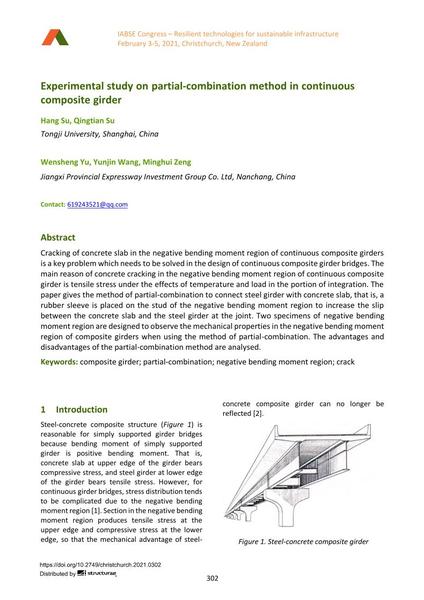Experimental study on partial-combination method in continuous composite girder

|
|
|||||||||||
Détails bibliographiques
| Auteur(s): |
Hang Su
(Tongji University, Shanghai, China)
Qingtian Su (Tongji University, Shanghai, China) Wensheng Yu (Jiangxi Provincial Expressway Investment Group Co. Ltd, Nanchang, China) Yunjin Wang (Jiangxi Provincial Expressway Investment Group Co. Ltd, Nanchang, China) Minghui Zeng (Jiangxi Provincial Expressway Investment Group Co. Ltd, Nanchang, China) |
||||
|---|---|---|---|---|---|
| Médium: | papier de conférence | ||||
| Langue(s): | anglais | ||||
| Conférence: | IABSE Congress: Resilient technologies for sustainable infrastructure, Christchurch, New Zealand, 3-5 February 2021 | ||||
| Publié dans: | IABSE Congress Christchurch 2020 | ||||
|
|||||
| Page(s): | 302-310 | ||||
| Nombre total de pages (du PDF): | 9 | ||||
| DOI: | 10.2749/christchurch.2021.0302 | ||||
| Abstrait: |
Cracking of concrete slab in the negative bending moment region of continuous composite girders is a key problem which needs to be solved in the design of continuous composite girder bridges. The main reason of concrete cracking in the negative bending moment region of continuous composite girder is tensile stress under the effects of temperature and load in the portion of integration. The paper gives the method of partial-combination to connect steel girder with concrete slab, that is, a rubber sleeve is placed on the stud of the negative bending moment region to increase the slip between the concrete slab and the steel girder at the joint. Two specimens of negative bending moment region are designed to observe the mechanical properties in the negative bending moment region of composite girders when using the method of partial-combination. The advantages and disadvantages of the partial-combination method are analysed. |
||||
